
On the night of Jun 30/Jul 01 2018, from about 10:30 PM until dawn, through hazy, moonlit skies, I acquired a set of observations of the likely black-hole system MAXIJ1820+070, (also known as ASASSN-18ey ).
I adjusted the altitude axis by 1/4 notch CCW, but overshot the mark again. It's very hard to make adjustments of the required size.
The night was very warm and humid -- temperatures in the high 80s F and relative humidity 67 percent. Condensation formed on the dewar window around 2 AM. I tried changing the camera temperature to remove the moisture, and kept working, but the measurements were not worth keeping. Rats.
The main setup was:
Notes from the night:
This optical and X-ray and radio transient is likely a black hole accreting material at a higher-than-usual rate. It has been the subject of many observers over the past few months -- see the trail of telegrams that include
The object is located at
RA = 18:20:21.9 Dec = +07:11:07.3
A chart of the field is shown below. The size of the chart is about 22 by 18 arcminutes.
I've marked the location of several comparison stars, which also appear in light curves below. Stars C, D, and E are mentioned by the Tomoe Gozen team in ATel 11426, but all three are rather red, with (B-V) ranging from 1.14 to 1.37. Star B is one of the bluest nearby bright stars, with (B-V) = 0.52.
star UCAC4 B V ---------------------------------------------------- B 486-079513 12.975 12.454 C 486-079608 13.968 12.830 D 486-079523 14.637 13.272 E 487-077858 14.637 13.272 ----------------------------------------------------
I ran the camera at -10 C early, because it was so warm. After the condensation appeared, I heated it up to +10 C briefly, then settled at +2 C.

The sky value shows light clouds and a rising value due to the moon. The gap represents the time I spend fiddling with temperature. I didn't use any data after the gap.

Here's a record of the telescope's drift. At the start of the night, I turned the altitude knob 0.25 notches CCW, which once again overshot the proper position. It's not clear how to make very small adjustments properly ...
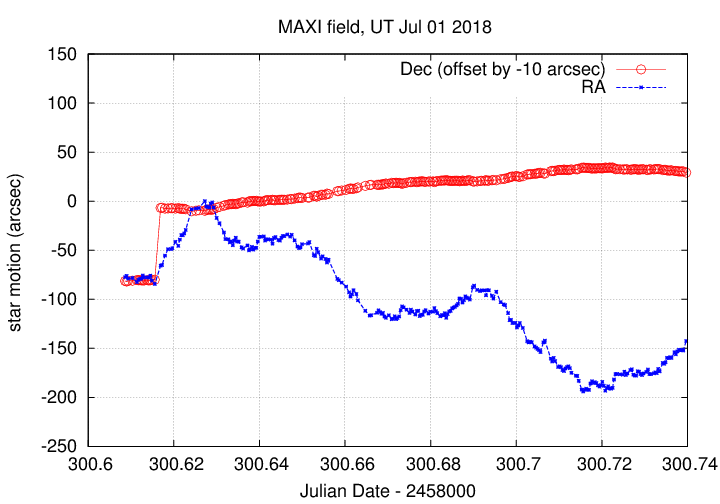
The number of objects detected -- I required 50 objects for an image to be included in the ensemble.
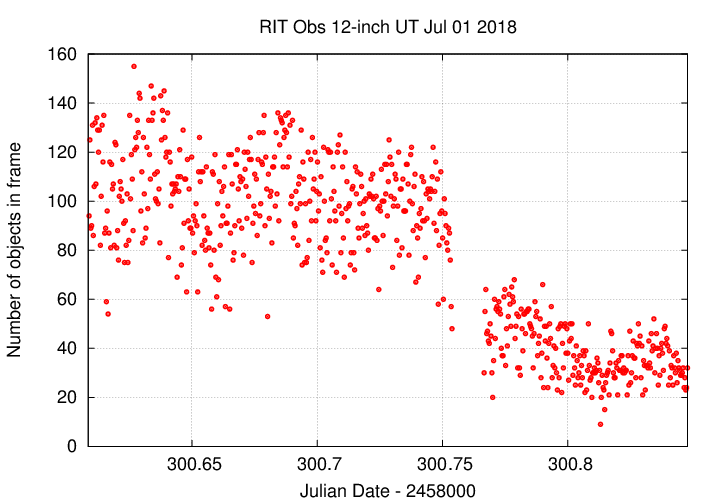
I used an aperture with radius 5.0 pixels. I adjusted the focus position from 0.815 -> 0.835 at 1:52 AM.

I discarded images which had obvious trailed stellar images, (170 of the 660 raw images).
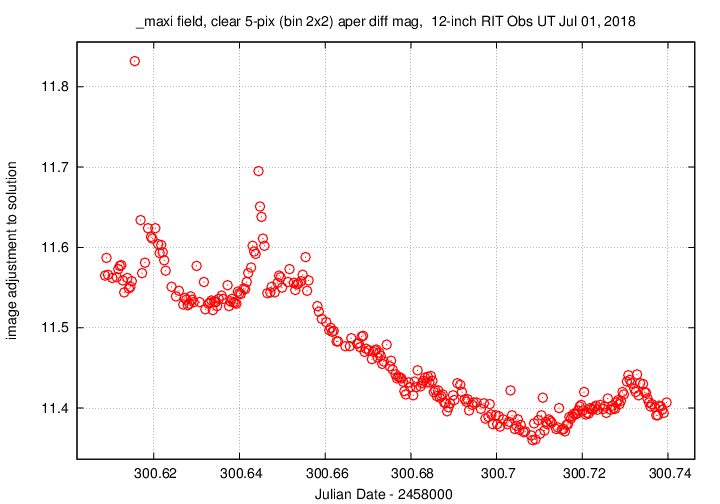
Using aperture photometry with a radius of 5 pixels (binned 2x2, each pixel is 1.34 arcsec, so a radius of 6.7 arcsec), I measured the instrumental magnitudes of a number of reference stars and the target. Following the procedures outlined by Kent Honeycutt's article on inhomogeneous ensemble photometry, I used all stars available in each image to define a reference frame, and measured each star against this frame.
Sigma-vs-mag plots show that the floor was about 0.006 mag overall, pretty good. I marked star "A" as variable in the ensemble, as it was slightly saturated. The big outlier around instrumental magnitude 2.2 is MAXI J1820+070.
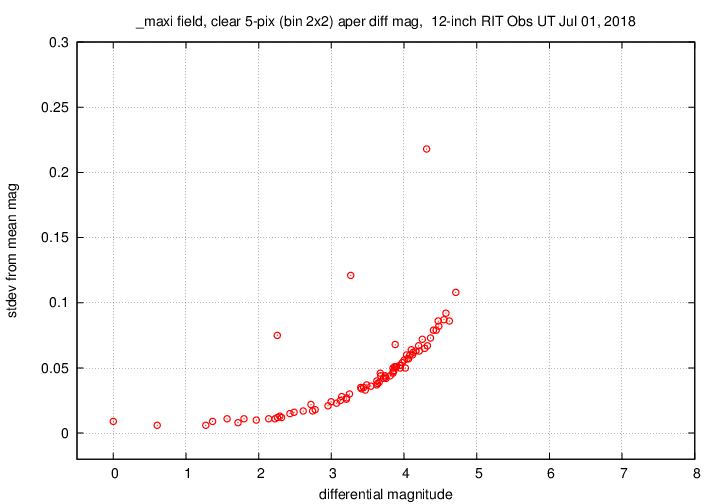
Here are light curves of the variable and the field stars.
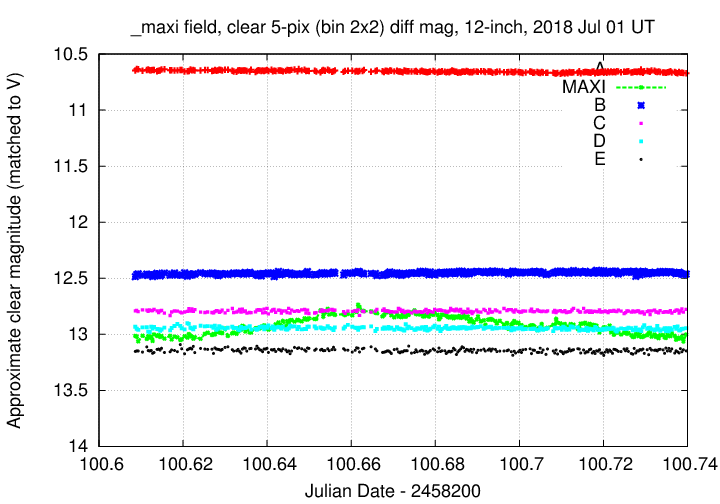
I used the UCAC value for the V-band magnitude of star "B" = UCAC4 486-079513 to shift the ensemble magnitudes to the standard V-band scale -- but remember that these are UNFILTERED measurements.
Here's a closeup on the variable. I'll connect the dots to make its behavior a bit easier to see.
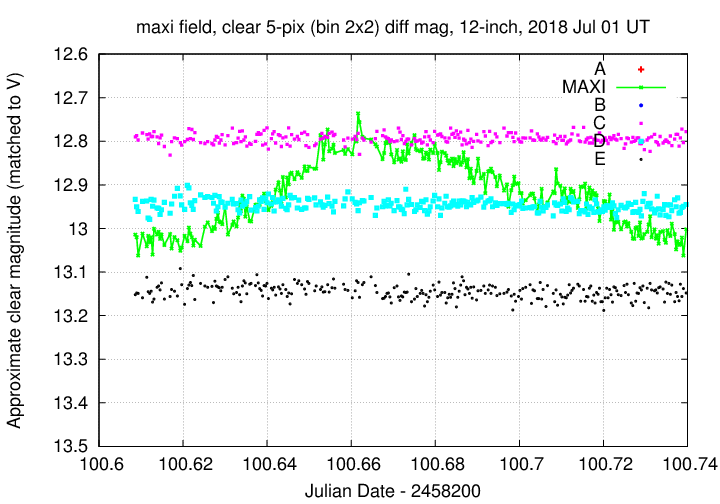
You can download my measurements below. A copy of the header of the file is shown to explain the format.
# Measurements of MAXIJ1820+070 made at RIT Obs, UT 2018 Jul 1, # in fair conditions, # by Michael Richmond, # using Meade 12-inch LX200 and ATIK 11000. # Exposures 25 seconds long, no filter. # Tabulated times are midexposure (FITS header time - half exposure length) # and accurate only to +/- 1 second (??). # 'mag' is a differential magnitude based on ensemble photometry # using a circular aperture of radius 5 pix = 6.6 arcseconds. # which has been shifted so UCAC4 486-079513 has mag=12.454 # which is its V-band magnitude according to UCAC4. # # UT_day JD HJD mag uncert Jul01.10863 2458300.60863 2458300.61368 13.014 0.014 Jul01.10897 2458300.60897 2458300.61402 13.020 0.014 Jul01.10932 2458300.60932 2458300.61437 13.062 0.015
Last modified 6/29/2018 by MWR.